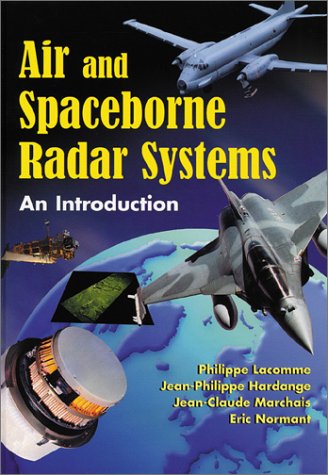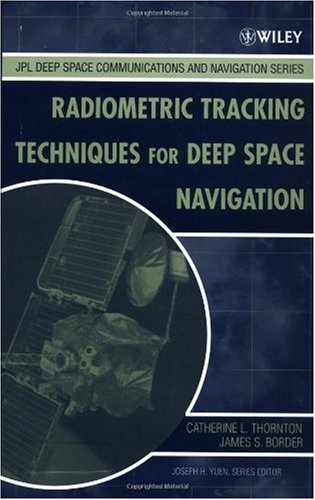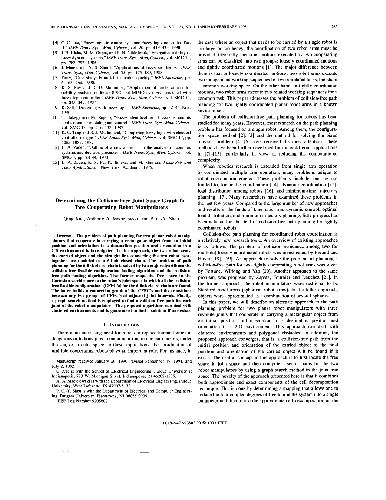P. Lacomme, J.C. Marchais, J.P. Hardange and E. Normant9780852969816, 0-85296-981-3, 1891121138
Table of contents :
Air and Spaceborne Radar Systems: An Introduction……Page 1
Title page……Page 2
Copyright……Page 3
Other Books Under the SciTech Imprint……Page 4
Table of Contents (linked)……Page 5
Foreword……Page 16
Preface……Page 17
Remark……Page 18
PART I General Principles……Page 19
Maritime Patrol Radar (Ocean Master)……Page 20
1.1 History……Page 21
1.2 Basic Principles……Page 22
1.2.1 Basic Configuration……Page 23
1.2.1.1 Range Measurement……Page 24
1.2.1.2 The Invention of Monostatic Radar……Page 26
1.2.2 Choice of a Wavelength, fOL……Page 32
2.2.1 Surveillance……Page 33
2.2.2 Reconnaissance……Page 34
2.2.3 Fire Control and Targeting……Page 35
2.4 System Functions……Page 37
2.5 Definitions of Flight Conditions……Page 39
3.2.1 The Role of the Antenna on Transmission……Page 41
3.2.3 Reflection from the Target……Page 42
3.3 Radar Equation in Free Space……Page 43
3.4.1 Example of the Double Spheres……Page 44
3.4.2 General Example……Page 46
3.5 Mathematical Modeling of the Received Signal……Page 48
3.6 Direction of Arrival and Monopulse Measurement……Page 51
3.6.1 Angular Fluctuation (Glint)……Page 52
4.2.1 The Reflection Phenomenon……Page 54
4.2.2 The Presence of Obstacles—Diffraction……Page 60
4.3.1 Normal Propagation……Page 61
4.3.2 Abnormal Propagation……Page 63
4.3.3 Atmospheric Absorption……Page 64
4.4 Other Phenomena……Page 65
5.2.1 The Characteristics of Thermal Noise……Page 66
5.2.2 Definition of the Noise Factor……Page 67
5.2.3 Noise Factor in a Reception Chain……Page 68
5.3 Radiometric Noise……Page 69
5.4.1 Clutter and Ground Clutter……Page 70
5.4.1.1 Homogenous Clutter……Page 71
5.4.1.2 Measurement of the Backscattering Coefficient……Page 72
5.4.1.3 Ground Clutter Models……Page 73
5.4.1.4 Ground Clutter Spectrum……Page 74
5.4.2 Sea Clutter……Page 75
5.4.3 Meteorological Echoes (Atmospheric Clutter)……Page 76
6.1 Introduction……Page 78
6.2.1 Definition of Processing……Page 79
6.2.2 Interpretation of the Optimal Receiver……Page 81
6.2.3 Signal-to-noise Ratio at the Optimal Receiver Output……Page 82
6.2.4 Signal Detection in White Noise……Page 84
6.3 Optimal Receiver for Known Non-white Noise……Page 88
6.4 Adaptive Receiver for Unknown Non-white Noise……Page 89
6.4.1 Adaptive Radar with a Noise-only Reference Signal……Page 90
6.4.2 Adaptive Radar without a Noise-only Reference Signal……Page 91
6.5 Space-time Adaptive Processing……Page 94
6.6 Waveform and Ambiguity Function……Page 95
6.6.1.1 Definition……Page 97
6.6.1.3 Examples of the Ambiguity Function……Page 98
6.6.1.4 Range-Velocity Ambiguity……Page 99
6.6.2 Resolution Capability……Page 101
6.6.3 Precision of Range and Velocity Measurement……Page 103
Fighter Radar Under Test in an Anecoid Chamber……Page 105
PART II Target Detection and Tracking……Page 104
7.2.1 Calculation of Ground Clutter Received by the Radar……Page 106
7.2.2 General Clutter Cancellation……Page 109
7.2.2.2 Angular Selectivity……Page 111
7.2.2.4 Velocity Selectivity……Page 112
7.2.2.5 Comments on Ground Clutter Cancellation Methods……Page 113
7.2.3 Clutter Cancellation and Waveform Selection……Page 114
7.2.3.2 Pulse Radar……Page 115
7.2.3.4 High Pulse Repetition Frequency Radar (HPRF)……Page 117
7.2.3.5 Medium Pulse Repetition Frequency Radar (MPRF)……Page 119
7.3.1 Definitions……Page 120
7.3.2.1 Modeling……Page 122
7.3.2.2 Transmitter and Receiver Behavior……Page 123
7.3.2.3 Spectral Noise Properties……Page 124
7.3.3.1 Improvement Factor and Spectral Purity……Page 127
7.3.3.2 Influence of Processing and Waveform……Page 128
7.3.3.3 Influence of Spectral Purity……Page 129
7.4 Dynamic Range and Linearity……Page 131
8.2 Non-coherent Low-PRF Mode……Page 133
8.2.1 Waveform and Theoretical Processing……Page 134
8.2.2 Non-coherent Radar Block Diagram……Page 136
8.2.2.1 Filter Matched to Unit Pulse……Page 137
8.2.2.2 The CFAR……Page 139
8.2.2.3 Envelope Detection and Post-detection Integration……Page 141
8.2.2.4 Target Detection……Page 142
8.3.1 Definition……Page 145
8.3.2 Pulse-compression Radar Block Diagram……Page 146
8.3.3.1 Linear FM……Page 147
8.3.3.2 Pulse Compression by Phase Coding……Page 148
8.4.2 Coherent Low-PRF Radar Theoretical Analysis……Page 149
8.4.3 MTI Basic Block Diagram……Page 151
8.4.5 Airborne MTI (AMTI)……Page 154
8.5 High-PRF Radar……Page 155
8.5.1.2 Modulated CW Radar (Range Measurement)……Page 156
8.5.2.1 Definition……Page 157
8.5.2.2 0.5-duty Cycle, High-PRF Radar……Page 158
8.5.2.3 IF Filters……Page 159
8.5.2.4 Performance Calculation, Processing Losses……Page 160
8.5.3.1 Frequency Modulation……Page 162
8.6.1 Definition……Page 163
8.6.2 Ideal Pulse-Doppler Receiver……Page 164
8.6.3 Pulse-Doppler Radar Block Diagram……Page 167
8.6.4 Range Gate Sampling……Page 168
8.6.6 Eclipse and Ambiguity Elimination……Page 170
8.6.7 Detection Performance……Page 172
8.6.7.1 Calculating False-alarm probability……Page 173
8.6.7.3 Radar Range……Page 174
9.1 Introduction……Page 176
9.2 Platform Motion and Attitude—Coordinate Systems……Page 177
9.3.1 Definition……Page 178
9.3.3 General Structure of Tracking Loops……Page 179
9.3.4.1 The Discriminator……Page 180
9.3.4.2 The Loop Transfer Function……Page 181
9.3.6 Angle Tracking……Page 182
9.4.2 Trajectory Estimation……Page 183
9.4.3 Tracking Management and Update……Page 185
9.5 Track-While-Scan (TWS)……Page 186
10.3.1 Low-speed Aircraft (Helicopters)……Page 187
10.3.2 High-speed Aircraft (Airplanes)……Page 188
10.3.2.1 Displaced Phase Center Antenna (DPCA)……Page 189
10.3.2.2 Space-time Adaptive Processing (STAP)……Page 191
11.1 Maritime Surveillance Radars……Page 193
11.2.2 Platform Altitude……Page 194
11.3.1 Pulse-repetition Frequency……Page 196
11.3.5 Processing……Page 197
11.4.1 Processing……Page 198
11.4.3 Pulse-repetition Frequency……Page 200
11.5.3.1 Plot-target Association……Page 201
11.5.3.2 Filtering……Page 202
11.6.2 Range Profile……Page 203
11.6.3 Imaging……Page 204
12.2 Electromagnetic Compatibility……Page 205
12.3.1 Frequency Source (Master Oscillator Exciter)……Page 207
12.3.3 Antenna Assembly……Page 208
12.3.4 Intermediate Frequency Receiver……Page 209
12.4.1 Decoupling the Antenna Systems……Page 210
12.5.1 Interactions Outside the Radar Bandwidth……Page 211
12.5.2 Interactions Inside the Radar Bandwidth……Page 212
PART III Ground Mapping and Imagery……Page 214
Two Axis ESCAN Fighter Radar (RBE2 Radar of the Rafale)……Page 215
13.2.1 Aircraft Motion……Page 216
13.2.2 Beam Shape……Page 217
13.2.3 Signal Dynamics Adaptation: STC and Log Receiver……Page 218
13.2.4 Angular Resolution……Page 219
13.3 Ground Mapping with Monopulse Sharpening……Page 220
13.3.2 Sharpening by Compression……Page 221
14.1 Imaging Radar Applications……Page 222
14.2.1 Resolution……Page 223
14.2.1.1 Temporal Resolution and Frequency Bandwidth……Page 224
14.2.1.2 Frequency Resolution and Duration of the Analyzed Signal……Page 225
Duration of the Analyzed Signal……Page 226
14.2.4 Radiometric Resolution……Page 227
14.2.6 Contrast……Page 229
14.2.7 Dynamic Range……Page 231
14.2.7.1 Noise Introduced by ADCs……Page 233
14.2.7.2 Total and Instantaneous Input Signal Dynamic Range……Page 235
14.3 Special Techniques for Range Resolution……Page 237
14.3.1.2 Performance Characteristics……Page 238
14.3.1.3 Sizing Constraints……Page 240
14.3.2.2 Performance Characteristics……Page 241
14.3.2.3 Sizing Constraints……Page 243
14.3.3.1 Basic Principles……Page 244
14.3.3.2 Pulse-compression Algorithm……Page 245
14.3.3.3 Application……Page 247
15.1 Design Principle……Page 248
15.1.1 Synthetic Aperture Radar: a Type of Doppler Processing……Page 249
15.1.2.1 Geometry and Angles……Page 250
15.1.2.2 Unfocused Synthetic Aperture……Page 251
15.1.2.3 Focused Synthetic Aperture……Page 252
15.1.2.5 Unfocused SAR Limit……Page 257
15.1.3 A Remarkable Configuration: the Side-looking Antenna Radar……Page 259
15.1.4 Ultimate SAR Resolution……Page 261
15.2.1 Range Ambiguity……Page 263
15.2.2 Cross-range Ambiguity……Page 264
15.3 Spaceborne SAR……Page 266
15.3.1 Side-looking Focused SAR Resolution……Page 267
15.3.2 A Range-ambiguous Waveform……Page 269
15.3.3 Antenna Surface Area……Page 270
15.3.4 Doppler Frequency and Yaw Steering……Page 272
15.4 SAR Operating Modes……Page 274
15.4.1 Doppler Beam Sharpening, with Rotating Antenna……Page 275
15.4.2 Spotlight SAR……Page 276
15.4.3 Scansar……Page 277
15.4.5 Multilook Mode……Page 278
15.4.6 Other Modes……Page 279
16.1 Migrations……Page 280
16.2 Phase Errors……Page 281
16.2.1 Effect of a Periodic Phase Error of Frequency……Page 282
16.2.2 Effect of a Random Error……Page 286
16.3 Platform Motion……Page 288
16.3.1 Calculation Example: Motion along Platform Flight Axis……Page 289
16.3.1.1 Slow Periodic Motion……Page 290
16.3.1.2 Random Motion at Low Frequency……Page 291
16.3.2 Calculation of Transverse Motion and Vibration Effects……Page 293
16.3.3.1 Longitudinal Motion……Page 294
16.3.3.2 Transverse Motion Vibrations……Page 295
16.3.4 X-band or L-band?……Page 296
16.4.1 Modeling……Page 297
16.4.2.1 Slow Deviations in Frequency……Page 298
16.4.2.2 Spurious Lines……Page 299
16.4.3 Other Sources of Frequency Instability……Page 300
16.5 Signal Processing……Page 301
16.5.1 Transfer Function……Page 302
16.5.3 “Single-pass” Processing……Page 305
16.5.4 Multilook Processing……Page 307
16.6.1 Introduction……Page 309
16.6.2 Multilook Registration……Page 312
16.6.3 Contrast Maximization……Page 316
16.6.4 Phase Gradient……Page 318
16.6.5 Asymptotic Performance of Autofocus……Page 326
16.7.1 Power Budget for Point Targets……Page 330
16.7.3 Multilook Processing……Page 331
16.8.1 Localization Model……Page 332
16.8.2 Bearing Measurement Accuracy……Page 334
16.8.3 Computation of the Geographical Localization Error……Page 335
16.8.3 Example……Page 336
16.9.1 Moving Target Detection……Page 337
16.9.2 Height Measurement Using Interferometry……Page 338
16.9.3 Polarimetry……Page 341
16.9.5 Thematic Processing……Page 343
17.2.1 Basic Principles……Page 344
17.2.3 Projection Plane……Page 346
17.3.1 Modeling……Page 348
17.3.2 Application……Page 349
18.1.1.2 Broad Bandwidth Transmission……Page 351
18.1.3 Cable RCS……Page 352
18.2 Scatterometers……Page 353
18.2.1.1 Basic Measurement Principles, Algorithm……Page 354
18.3 Altimeters……Page 355
18.3.1 Antenna Beam……Page 356
6.3.2.2 Pulse-limited Operation……Page 357
PART IV Principal Applications……Page 358
MSCAN Fighter Radar (RDY Radar of the Mirage 2000)……Page 359
19.1.3 Maritime Applications……Page 360
19.3.1.1 Operational Capabilities……Page 361
19.3.1.2 Ultimate Aim of the Mission……Page 362
19.3.2 Airborne Reconnaissance……Page 363
19.3.3 Air Surveillance……Page 368
19.3.4.1 Maritime Surveillance Missions……Page 369
19.3.4.3 Installation……Page 371
19.3.5 Battlefield Surveillance……Page 372
19.3.6 Air Superiority, Interception, and Combat……Page 375
19.3.7 Tactical Support, Ground Attack, and Interdiction……Page 378
19.3.8 Very Low-altitude Penetration……Page 380
20.1 Basic Equations……Page 383
20.3 Space Observation Radar……Page 385
20.3.2.1 Description……Page 386
20.3.2.2 Example……Page 387
20.4.1 AEW Specifications……Page 389
20.4.2.2 Choice of Frequency……Page 390
20.4.2.3 Choice of the Antenna……Page 391
20.2.3 Performance Calculations……Page 392
20.4.2.5 Determining the Required Transmission Power……Page 394
20.5.1 Surface Vessel Detecting Mode……Page 395
20.5.2 Detecting Small Targets (Periscope)……Page 396
20.6.2 Technical Description……Page 397
20.6.2.3 Antenna……Page 398
20.6.2.5 Processing Gain……Page 399
20.6.2.6 Transmitter Power……Page 400
20.7.1 Specifications……Page 401
20.7.2 Technical Description……Page 402
20.7.2.1 Velocity Search……Page 403
20.7.2.3 Tracking and Plotting……Page 404
20.8.1 Specifications……Page 405
20.8.2 Technical Description……Page 406
20.8.2.3 Air-to-ground Ranging……Page 407
20.8.2.6 Detection and Tracking of Ground Moving Targets……Page 408
20.8.2.7 Close Combat……Page 409
20.8.2.8 Technical Characteristics……Page 411
20.9 Penetration Radar……Page 412
20.9.2.2 Antenna Scanning……Page 413
20.9.2.3 Transmission……Page 414
21.2.1.1 The Air-to-air Function……Page 415
21.2.1.5 Remarks……Page 416
21.2.3.1 Antenna……Page 417
21.2.3.3 Other Considerations……Page 418
21.2.3.4 Space-time Management……Page 419
21.4.2 Transmitter……Page 420
22.2.1 The Analog Age……Page 422
22.2.2 The Digital Age……Page 424
22.2.3 The New Age……Page 426
22.3.1 Electronic Circuits……Page 427
22.3.2 Electronic Power Circuits……Page 428
22.3.3 Transmitters……Page 429
22.3.4 Antennas……Page 430
22.3.5 Exciters……Page 433
22.3.6 Receivers……Page 434
22.3.7.1 Signal Processing……Page 435
22.3.7.3 Radar Map Processing……Page 438
22.4.2 Resistance to Radiation……Page 439
PART V Radars of the Future……Page 441
23.2 Electromagnetic Signature……Page 442
23.3.1 Effects that Produce RCS……Page 443
23.3.3 Some Values for RCS……Page 445
23.3.4 Radar RCS……Page 446
23.3.4.2 Reflection……Page 447
23.4 Reducing Electromagnetic Signature……Page 448
23.4.1.3 Absorbent Materials……Page 449
23.4.1.4 Electronic Devices……Page 450
23.5 Conclusion……Page 451
24.2 RCS Values……Page 453
24.3 Detection Range……Page 454
24.5 Missions……Page 455
25.2.1 Power Budget……Page 457
25.2.3 Limits on Accuracy in Measuring Target Parameters……Page 459
25.2.4 Resolution Limits……Page 460
25.3.1 Waveform……Page 461
25.3.3 Data Flow……Page 462
25.3.4 Exploitation……Page 463
26.1 Introduction……Page 464
26.2.1.2 New Detection Strategies……Page 465
26.2.1.4 Beam Shaping—Digital Beam Forming……Page 466
26.2.2.2 Scanning Flexibility/Intelligent Energy Management……Page 467
26.2.3.3 Beam Shaping……Page 468
26.3 Competing ESA Solutions……Page 469
26.3.1 Reflectarray……Page 470
26.3.2 RADANT ESA……Page 471
26.3.3 Active ESA (AESA)……Page 472
26.4 Conclusion: ESA Solutions for Airborne Radars……Page 473
27.2.1 Power Budget Increase……Page 475
27.2.2 Using Low-frequency Bands……Page 476
27.2.3 Multistatic Radar……Page 477
27.3.1 Waveforms……Page 478
27.3.2 Beam Matching (Digital Beamforming)……Page 479
27.4.1 Electronic Scanning: Detection and Scanning Strategies……Page 480
27.4.2 Conformal Antennas and Dispersed Antennas……Page 481
27.5.3 Air-Space Cooperation……Page 482
28 Conclusions……Page 483
List of Acronyms……Page 485
List of Symbols……Page 489
Bibliography……Page 492
About the Authors……Page 497
Index……Page 499
RR……Page 0







Reviews
There are no reviews yet.